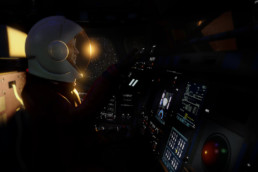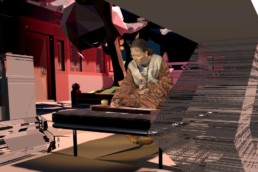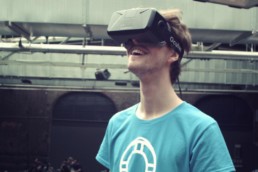Creative Studio
Digital storytelling in VR
No happy ending without a story
Since the time people started using language, they have liked to immerse themselves in stories. And that hasn’t changed. Whether we are at home at home or losing ourselves in a captivating storyline in a comfy cinema chair, we love to get carried away by stories. It doesn’t matter if it happens with books, movies or just narrated stories. A well-performed story moves the viewer or listener. That’s why the element of storytelling is also a crucial component in marketing. It helps to build a bond between the consumer and the product. But simply telling a story is often not enough. It should be clear from the start how good storytelling needs to be designed and what factors play a crucial role here.
Storytelling in VR
With the right storytelling it’s possible to arouse emotions and build much stronger interest. If you look at immersive media, the momentum is especially crucial, because content is much more sustainable in VR and AR. So it’s just as important to be aware of the possibilities and limits of this platform. When designing a VR Experience, it makes sense to base it on a journey or a sightseeing tour. A slow start is best, as many users have had little or no previous experience with VR. They will need some time to orient themselves and find their way around this new world.
Ideally, a VR Experience is like a museum visit. You can slowly move from work to work or get a general overview by going through quickly.
The personal preferences of different users should also be considered in the design.
Stylistic devices
Plan spaces
VR is a very space-immersive medium. The spaces should help convey the storytelling and make their own statement. Since we have limited options for cuts and montages in VR, it’s exciting to look at the staging strategies used in theatre here. Theatre is very experienced at portraying different scenes and stories within a limited space. Division into scenes often makes sense in VR.
Another interesting concept from theatre is the idea of a space within a space. When everything darkens on a theatre stage and a spotlight falls on a performer in one corner, the audience realises that they are now in another space, possibly even the performer’s inner life. Such effective staging can also be used in VR. Cuts and spatial jumps can be avoided by using intelligent lighting concepts.

Interaction concepts
One of the biggest decisions to make when designing a VR Experience is the question of interactivity. Whether it is a 360° video, a VR application with HTC Vive or another headset, it comes down to the question of how interactive the result should be. Of course, more interactivity means a more immersive experience, so the benefits of interactivity are obvious. The user can take their own path in the application and feels connected faster and more intensively to the world they are travelling. Interactivity is like a piece of chocolate: once you’ve tasted it, you want more.
But you have to be aware with any design that VR interactivity has limitations. You will reach limits in any experience where the user wants to do something that the design doesn’t allow. The task of storytelling is to make these limits as invisible as possible. Ideally, you guide the user in such a way that they don’t notice they have limitations. One good strategy is to sell the boundaries in a charming way. If, for example, as a user I can’t take a certain path, it makes sense to make this path unattractive or inaccessible in the virtual world. Storytelling in VR means also means knowing where boundaries should be set and how interaction can be restricted without being distracting.




